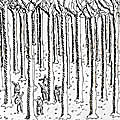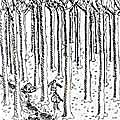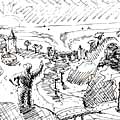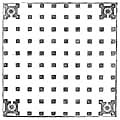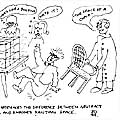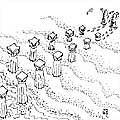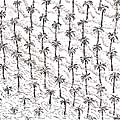![]()
![]()
![]()
![]()
![]()
![]()
![]()
![]()
![]()
![]()
![]()
![]()
![]()
![]()
" Empire of the Forest, Republic of the Valley "
THE 'EMPLOTMENT' OF THE 'TIME OF INFINITY' or the Time before TIME began AND 'SOMATIC TIME' or the TIME OF LIVING
Click once on the pictures to enlarge them to full screen size and bring up the Captions
EMPIRE OF THE FOREST
If one imagines climbing up over the rim of a high plateau, and then flying for hours over an infinite forest, featureless, and stretching to the horizon, undering a lowering, rain-filled sky, then hearing the engines splutter and expire. Surviving (which is technically unlikely in anything smaller than a Boeing 747) the crash-landing through the trees, one would find oneself in a trackless jungle, with a porous crust through which the frequent rains sank without trace. Which direction should one take to reach the edge of the plateau, and escape? Bereft of sunlight under the clouds and forest canopy, one tree follows another, and one space succeeds another, without difference or progression. One walks through a space of eternal sameness, like a hall of endless reflections, in which time seems merely to repeat itself and space to have neither direction nor distance. The unfortunate travellers have an experience of an eternal succession of present moments, all of which succeed each other without appearing to give rise to the passage either of time, or space.
REPUBLIC OF THE VALLEY
Then one of them comes upon a stream. Stooping down and placing her hand in the welcome rivulet she feels the water press upon her palm. In an instant she sees, in her mind's eye, the streamlet going to the edge of the high plateau. She stands upon a rock. The stream splashes away, falling down until it gathers with another in a mountain pool. Then, travelling less steeply, it emerges into a wider valley where it flows between squared fields. A bridge is visible in the far distance. Some towers and the cubic shapes of buildings outine a human settlement. Beyond that in the furthest hazy distance, a bright glimmer against the low sun on the horizon, she senses the line of the ocean.
In a flash all of the members of the party know that they are saved. Time has started to flow. The solid bar of water, with each molecule joined to its neighbour like the minutes of a life, will guide them out and down, across each of the expected 'horizons of the valley' until the infinite expanse of the open sea, which will join all of them to the world of the real time and space which had seemed, for some terrible days, to have been lost and gone for ever in the forest.
This peculiar environment, which I call the 'Space of Infinity' is the irreducible and necessary 'ground' of Architecture. Mies van der Rohe adumbrated it, in the aetiolated way of the 20C, when he averred that his first act in any project was to: "Visit its site and divine its Grid". Unfortunately he left no divinatory recipe.
SERLIO'S SURMISE.
Sebastiano Serlio describes it in one of his books, illustrated by Professor George Hersey in "Pythagorean Palaces, where he instances what he calles the 'hypostyle'. He illustrates it with a square building of 100 columns having a tower in each corner containing a spiral stair. This, Professor Hersey reports, Serlio describes as "the original building, the Council Hall of Athens". Such statements, made, as we know, by a writer ignorant of Athenian archaeology, are not to be understood literally. We may not think that Hellenic architects were as wedded to functionalism as we are, but not even an Ancient Greek, with all of their rhetorical sophistry, could have persuaded his Council to meet in a Prytaneion so entirely stuffed with columns that there was no room for anything else.
A clue here is that the Architectural Theorists of the Italian Renaissance, whenever they wished to invest an idea with the highest status, located its genesis in the 'Golden Age' of Antiquity. This entirely fictive time and place was always denoted by giving the favoured entity a Greek name and, if possible, locating it in Athens. Thus, for example, the topmost floor of a town house, open to the breeze and a bel-vedere, was called the Attica. We will return to this very important subject, of roof gardens, when we treat the "Entablature".
Serlio, therefore, in denoting the 'hypostyle' the Parliament of Athens, the model of the original Ideal City-State, was saying, in so many words, that this 'forest of 100 columns was, for some obscure reason, the 'original building'.
If we pursue the matter in Greek itself the plot becomes even more mysterious. For the Order, in Greek, has three parts. The stylion is the column itself. The epistylion, or that which is above the column, that the Renaissance came to call, more graphically, the Intablatura, is everthing that the column 'carries'. In this the Greek is more laconic than our own term. Strangest of all is the 'hypostylion', or that which lies below the column. It would not be so strange if this merely meant what it seems to mean, such as the foundation of the column, or Order. But the 'hypostyle', as it has come down to us in architectural literature, is not a mere mess of stone or concrete, or even a nicely cut plinth or stylobate (column-base), which has its own name. It is definitely a forest of uninterrupted columns. It can be noted that not even the Renaissance, with all of its inspired inventiveness, created a Latin equivalent to the idea of a forest of columns that (can we say?), in some way, "lies below".
MYTH AND PHILOSOPHY
Here, in order to illuminate my meaning, before I attempt to explain it in a more reasonably-argued way, I will recount two things, a Greek Myth and a notion of Kant's. Myth and philosophy share the medium of words but exist at opposite poles. Philosophy avoids language that relies on images, preferring figures, when used at all, of the kind drawn from geometry that Wittgensteain called Models. This attitude comes out in the 20C preference for axonometrics above all other spatial representations, especially vanishing-point perspectives. Myth, on the other hand, uses imagery in the way of a film, associating it with narrative so as to create fictive realities that are naturalistically fleshed. Our own technique avoids either of these routes, relying in an invention that I term 'iconic'. An icon, as we use it, is 'naturalistic, but not pictorial. Thus water is wavy and often blue, but then so is the bounding serpent of time, the icon of infinitude, with its oceanic and cthonic attributes.But neither does an icon attempt to be a geometrically, or logically homologous model whose 'points' map, one-to-one, onto the object to which the icon refers us. It is, unlike the axonometric, not a 'working drawing'. Its mode of working is literary rather than literal, and depends upon a literary en-crypter and a literary de-crypter.
To start with Kant, is to recount that he suggests that, in order to conceive of space as something real and concrete, as opposed to mere extension ad infinitum, in the style of Descartes, one remove a chair and imagine the space that its solid body once occupied. This is, very precisely in the style of Philosohy, conceiving of a chair not as an 'illusory' appearance, such as in a painting, but stereotmetrically, as in a three-dimensional 'model. But then this is, in fact the real medium of corporal experience in which Architecture works. So, very specifically in Architecture we have a fertile ground for an intellectually lethal confusion betwen the 'natural' modes of perception given to the architectural practitioner and the building technologist, and the preferred modes of abstracted conception employed by the Philosopher. This is a confusion which is constantly exploited by both Architectural Philosophers as well as Practitioners. It has rendered much of their 20C work ineffective either as Architecture or as Theory.
The Greek myth, as retailed by Hesiod, is that of Deucalion, son of Prometheus (forethought), and his wife, Pyrrha, daughter of Prometheus' brother, Epimetheus (afterthought) and Pandora. Prometheus, one of the Titans who sirvived the defeat of Cronus, created Mankind in opposition to the Olympians increasingly assertive government. Pandora was one of the punishments invented by Zeus for this insubordination. A genocidal flood was another, warned by his father, Deucalion built an Ark, and he and Pyrrha eventually re-landed, wisely sacrificed to Zeus, or possibly Themis, but in any case were awarded one wish in reward.
The couple asked, some say in Delphi, for the return of the human race.
Themis instructed them to loosen their girdles, cover their heads and walk, throwing the bones of their mother behind them. Having both separate mothers they interpreted this by picking up stones and flinging them over their heads. Wherever the stones of Deucalion fell, men sprang up, and wherever those of Pyrrha were cast, women emerged from the ground.
The couple built themselves a house, in which they lived together as a devoted pair, until a great age. After their death, they became two trees, which stood outside their house.
One of their sons was called Hellen, from whom descended all the Hellenes. Other sources describe Deucalion as the first King of Greece and the builder of cities and temples.
The myth appears to be a recipe for a repopulation method that proposes to grow people from stray rocks. Why take any interest in it?
My idea is that the story of Deucalion and Pyrrha is a 'mythic', reply to the important question "What is the world which humans being make for themselves when they build?" Deucalion was the son of the forge-fire-stealer. Pyrrha the daughter of a synthesised mother, made from clay by Hephaestus, on the order of Zeus, to plague mankind with beauty and adversity, alleviated by Hope. Both emerge from an unusually 'unnatural' genealogy of fabrication. Both enact a history of erasure and reconstruction, flood and re-seeding. Both have a difficult relation with the gods that eventually turns sweet after they follow, with a certain cunning, the orders of the Olympians.
Let us look at how the couple ended. They did so as they first conjured the human race, as standing beings that had emerged from the ground - in this case trees. The word for tree in German is baum, in Dutch it is boom. Both are related to the verb to 'be' and to the noun 'beam' as in a 'beam' of light. We can therefore justify the epithet 'beings' to describe the gendered pair of objects that stood in front of the couple's lifespace, or house.
We can equate these with a pair of guardians, or sentinels or whatever it is that is comprised in the term 'apotropaic columns'. Whatever this complex of ideas is, and it is indeed ancient and extensive, we can summarise it as constituting a 'door' or 'portal' to the house. Its precise degree of physical attachment is iconically irrelevant. I say this merely because it is 'facts' of that sort which naturally spring to the practising architects mind! Iconography is not the same as building construction!
The instruction from Themis, patroness of Order, Harmony and Law, was to loosen their clothing, become 'blind', (with passion?) and sow pebbles broadcast, much in the matter of the psephi, cast by the Thriae, the three blind nurses of Apollo, to divine the oracle traded by him for the musical 'speaking-tube' reed pipe invented by the infant Hermes. Graves speaks of the scene of the pebble-seeding as a dried river and an open plain. I always imagine the couple on a beach, devoid of any other feature except the flat infertile sand, newly liberated from the departed Flood. Having landed their Ark, they, like any seafaring colonists, when setting foot upon the site of a new foundation, built a fire, cooked a meal, and dedicated the best of it to the gods that had guided them to safety through the storm. Then after making their wish, they walked along the beach, casting their 'seeds' over their (reasoning) heads to land (at random, out of sight - and guided by the gods?) behind them.
As they did so an infinite army of people sprang into being. Deucalion and Pyrrha 'plant' their earthen seeds and bring forth an 'unplanned', and so 'authentic' crop of human 'trees'. We have already described one natural embodiment of the idea of Infinitude:- the boundless forest. But the Ocean is another such natural phenomenon which brings such an idea into being. The ritual of Deucalion and Pyrrha unite the oceanic flood and the 'automatically', or 'spontaneously' generating, climax vegetation, forest in the single locus of the edge of the flood - which we may call the 'beach'.
I will explore this periodically inundated terrain in the 'event horizon' of the Delta , which they Egyptians called the 'field of reeds' and equated with their hypostyle halls, in my texts dealing with the 'Republic of the Valley' .
What we can say here is that the 'mythic architecture' of forest and ocean interpenetrate in this 'Flood' myth of the Ancient Hellenes. The infinite forest of standing beings emerge not merely from below the earth, as the epithet hypostyle suggests, but from the very infinitude of the ocean itself. The 'forest' is both 'buried', or 'seeded', in the land and in the sea from which the land arose.
Francoise Choay, in "Rule and Model" quotes the Athenian in Plato's laws using this idea of 'things built' existing 'in potentia' below the ground from which, with the applicaition of some agency, they would rise. Her Note 117 to Chapter three reads : "The Athenian takes a stand against the walls: "As for city walls, Megillus, I'd agree with the Spartan view that they should be left lying asleep and undisturbed in the ground".
I also imagine that the Greek couple, possessed of their miraculous language and unable to practice it upon no-one but each other, were profoundly bored by the consequences of Zeus's genocide. Their request for companions was not borne out of any great love for humankind, but simply in order to widen their conversational horizons. Thus while they may have become trees after death, and merely rustled and sighed in the wind, giving off the occasional loud creak, their living was dedicated to the great Greek passion for richly-figured rhetoric. Their forest of standing beings, sprung from the earth, while borne of the sea and as infinite as the trees of the forest, talked among themselves. Their specific medium was the air they breathed and that carried the sound of their speech to each other.
One cannot possibly imagine a Hellene being satisfied by anything else.
So what has this, my own rhetorical confection, brought forth? It is a forest, an infinite forest, for we may not presume that the couple ceased from their 'walkabout', or, as the Greeks call it: 'peripaton' ,until populating the whole Earth with 'talking trees' - especially if these saplings spoke Greek. After which they built their own house, lived a long time (always a sign of favour from the gods) and died, becoming a monumental gateway to their own empty house, or 'kenotaph'.
SERLIO
Is this not a strikingly clear, and economical, decipherment of the peculiar assertion of Serlio that the Hypostyle is the 'first building', and that it is the 'talking-shop' of the Hellenes? The closely-spaced columns are a tight little crop, measuring 10 x 10, of the original 'talking trees' of the Hellenic regeneration myth. The big square towers on the corners, with their spiral cores, are both the commemorative funerary columns of the dead couple - or the 'supports' to the 'cosmic ceiling', which the West inherits from the Egyptians, and which shelters the 'word-making beings' of the 'Athenian council'.
All of this leaves us with a clear idea of what Architectures, in cultures from the Renaissance to Ancient Greece, from Egypt, to India, and even to Mesoamerica, deploy as their 'originary ground'. But how to go on from there? What exactly was the 'House' that Deucalion and Pyrrha built? After all, that is the question we want to be able to answer. It is very well to know the beginning. But what of the end, or even Chapter two? Even the Egyptians passed through their hypostyle halls, and their 'field of reeds' to the 'other side'. One can not linger for long in a room filled with such gigantic columns that there is not room for anything else.
We can now turn to Kant, and the question to which we can see no useful answer: "how can one bring concretely to mind something that has no substance, such as 'space'? Kant suggests imagining the ghost, or previously occupied space, of a removed object, (was he in the habit of practical jokes, like getting friends to sit down on absent chairs?) Husserl was more ambitous still, desiring to concretise, or model, and yet also make into a real experience, an even more ephemeral idea, that of Time.
POPULATING A LIFESPACE WITH "BEINGS" IN THE FORM OF IDEAS.
If we bring these two things together, we will argue that the Greek Myth, Serlio's 'useless' building, and the 'Kantian Solid' can be put together in a way that can do Modern Architecture a service. We know, one must suppose, even at the end of the 20C, that Architecture was the Medium which humans always used to make their own, specific, lifespace, as a space in which ideas are made real and concrete by embodying them in built equipment. This equipment was, and in many cases still is, then 'put into operation' through the agency of ritual. One must, I feel, repeat for the present generations, that the purpose of this 'operation' is not to contemplate the marvellous whizzing and clanking of some primitive assemblage passing under the inflated title of 'High Tech', or the merely trivial 'playing of light' upon some gratuitous form, but to 'bring into being' the somewhat the more urgent concepts (which have varied widely) needed to bond groups of people into functioning societies.
We also know, and here the 'moderns' will have no difficulty with their intuitions, that this 'architectural machinery', and its associated rituals, had become slowly more and more dysfunctional until, in the early 20C, it began to be scrapped as beyond repair. Before we enthuse too wildly around this 'bonfire of the vanities' we can, in the 21C, take a step back and examine what it was that was being destroyed. For one thing that the 20C has given us, is the ability to understand what, it is clear, the early 20C either did not or could not decipher, or having decoded, see no way of Modernising.
What, then, was this 'hypostylar ground' (that even Mies van der Rohe wrote as his 'first rite of design'), and what can it mean to us today?
I argue, in my essay on the ceiling of Martell Hall, at Rice, that St. Augustine proposed that God, before he 'created', created Nothing. The ceiling installs this idea and discourses on its consequences in the specific medium of a graphic installed between us, standing, talking, (thus social) beings, and the Cosmos that lies, somewhat inevitably, above our heads. In that essay I also argue that, as in the primum mobile, nothing else can come into existence, especially in the realm of ideas, without the symmetrical emergence of its opposite. How then can one characterise 'Nothing' in Architecture. Perhaps first one should describe what is an Architectural 'creation'.
Here the received truth is that Architecture is, above all, the invention of special kinds of space. If that is so then what is the 'negation' of space? What is the 'stuff of anti-space'? Surely that would be a solid, completely devoid of space, such as a block of solid concrete, or stone. The natural analogue of this 'great lump' of dark matter would be a mountain, filled with uncountable tons of rock without a chink of space or light in its replete interior. Indeed one can hardly talk of the 'interior' of a solid that is 'the same all the the way through'.
But how can we use such an idea in Architecture? This is a notion belonging to sculpture. Architecture is almost the only Medium open to all, without exception, (that is as a thoroughky unskilled and de-professionalised Medium), that goes beyond the mere 'contemplation' of an idea, 'from the outside', and allows one to enter right into an idea, realising it as an 'embodied being', akin to our own Being, and by the agency of our own being 'in the idea'. One can not 'enter into' a solid block of matter. Therefore the idea fails as the embodiment of the 'Negation of Space', in the Architectural Medium.
We come now to the Hypostyle and can better understand how it has always been the tool whereby, in Architecture, the idea of a plenitude, stretching to infinity, of an absolute identity of sameness, can come to embody the experience of Nothingness. If one could really build such a field of vast , tightly-packed, columns, square miles upon square miles in area, each identical, each made of mirror-polished blackness, upon a black floor and below a black ceiling, and imagine being placed into it and wandering for days without escape from it, one might come to believe, indeed, that Time and Space had yet to be born and one had entered into, and had being inside, the 'Architecture of Negation'.
However, bearing in mind the unquenchable tendency for human beings to entertain unreasonable fantasies and hopes, how large would such a 'hypostyle hall' have to be to bring about this 'full experience' of the idea of Negation? Surely at least as large as the largest urban park. Now the Agencies with the will to construct such vast 'experience machines' have never been in plentiful supply. Even the ancient Egyptians, who fully understood the conceptual function of the Hypostyle, limited themselves to rooms which, let us face it, could be traversed far too soon to engender the full 'horror nihilorum'. We can say, therefore, that whenever the Hypostyle has been 'built in full' it was still only built as a momentary experience that still had to be extrapolated to the full apprehension of the 'loss of time and space'. Moreover, due to the fact that the embodiment of Negation could serve, by definition, no 'other' Architectural service (as Architecture entails the 'enjoyment' of space), one had to 'pass through it' rather than remain and live in it. Thus it is that the Hypostyle is always a 'Hall', that is to say an ante-chamber to the place which is more permanently occupied, and in which persons assemble. Unless, that is we are to take Serlio literally!
We can begin, now, to understand why it is that all Architectures predicate the 'hypostyle' as the 'ground' of their design rituals, why so few of them are actually constructed, in toto, and why those that are serve merely as antechambers, 'beginnings' to both the 'promenade architecturale, and the business in hand.
We may also begin, then, to measure the revolution in efficacy which could be born of the use of the peculiar notion of Immanuel Kant. For what is promised if one could 'build' the Hypostyle of Negation and then absent it, while still entertaining its 'corporeal' presence, is nothing less than the installation of an Architecture that would remain, throughout every vicissitude, fully grounded in its own Negation, and thus 'in being' with a power that could both never be exceeded, and, which is almost more incredible, never be less than very practical, in almost every way, because physically absented!
This is the ambition which JOA has doggedly pursued for the whole of its 37-year existence and which has now been proved possible. The 'Working Order' in superimposing all of the 'Vitruvian Functions' on the same footprint, namely that of the Order itself, make of the entire building a 'Hypostyle Hall' which is 'automatically''invested it with every other function, without detracting from the power and terror of the original 'Architecture of Negation'.
However there are, as one might expect, two preconditions to the 'working' of the 'Kantian Solid'.
The first is that the 'absented object' is something that is very familiar to us. For us to recall it in its total coporality, when it has been 'absented', the 'object' needs to be something that is known by the whole human being. It is good if one has sat on it, bathed in it, climbed up it, fallen off it, touched it, smelt it and tasted it. If it has been apprehended with all of ones mind and senses, one may have some confidence that when it is removed, and only its 'inscribed traces' left behind, it will, like an amputated limb, linger in the space that it once 'filled', and still seem to be 'physically there'.
The second precondition is that the absented object be the subject of a vast and grippingly fascinating body of ideas that I will, in order to be provocative, denote as the 'arcana'. For it is not entirely clear why one should trouble to recall an absent thing if one obtains no intellectual profit from it. After all, we tend not to throw away enough and become buried in objects in this age of manufactures.
This second preconditon is the entire opposite of the first. While the first needs to be most familiar, the second profits from being difficult, complex and arcane, for only that can provide both the intellectual span as well as the deep penetration needed to provide a real magnetism to the oppressed, overloaded and jaded contemporary mind. The first benefits from being most natural, the second from striving for the greatest artifice and artificiality in its Art.
Here we can note, in passing the failure of the critics and writers on Architecture to serve their function for the last 50 years. This has been most striking in Italy, where, instead of building on Post-War Neo-Liberty, by far the earliest critique of 'white' Modernism, writers like Tafuri and Publicists like Gregotti chose to make theory an instrument which would render the Renaissance indecipherable. Instead of re-calibrating their writing so that it reinvented the 'arcana' fabricated by their Architectural predecessors, making it usable for contemporary practice, they invented a mass of equally fictitous verbiage whose ambition was to leave the history with no comprehensible links to their (never adequately argued) 'future'. We will never know whether the Critical Theorists of the Italian Universities, prettily ensconsced in cities of an architectural culture which, on the whole they had a fair understanding, were too uninventive to modernise that 'understanding', and make it usable, or clever enough to do it, but too cussed to make its arcana 'globally public'.
The upshot of these two 'preconditioins' is that 'poetics' are the foundation of the 'coming into being' of a 'Kantian Solid'. For what are poetics but the conjuring, in some medium, of a powerful 'embodiment', which we may call a 'virtual presence', or a 'virtual experience'? This explains the constant advice, in all Renaissance Architectural and Artistic theory, to "study Nature". But where are the Doric Entablatures in Nature? So degenerate did Architectural theory become, after the 1500's, or perhaps so persuaded of its own supremacy, that by the 1900's we have the unedifying spectacle of the Queen Anne 'sunflower cult' and Theodore Dresser's attempts to 'naturalise' ornament.
The fact is that the Architectural Orders are complete fictions, invented to be plainly artificial and not craggy with bark and wispy with twiglets and dead leaves. They are waxed and painted and carved, as they were in Antiquity, to render them even more 'artificial'. In JOA we deliberately 'colour-stain' our otherwise heavy and solid materials in order to make this point. Ideas such that the Orders were 'given by God', or 'can be found in Nature', or 'represent rational structure', or should always be made of wood and stone have the effect of abolishing the distance between the first and second preconditons and reduce Architecture to the conceptual banality we find today.
The best way to energise the process of 'ideating' the artifice of the humane lifespace is to build-in a big gap between its artificiality and the natural model to which it, in some way, corresponds. The mind, and especially the literate mind, works to 'close' this gap, bringing thoughts into being to serve its purpose. The largest 'gap' possible is to physically absent the model, leaving only the 'traces' of its 'previous' (as it were originary and 'real') existence. Our own contemporary building technology allows us to use this, most brutally powerful of all techniques, more than could be done during the Renaissance. It is this improved technique that allows us to largely dispense with the Renaissance's own most powerful tools: the evocation of the fictive realm of Antiquity, the use of elaborate 'courtly rituals', and the compulsion to 'overcook the dish'.
Almost everything in Mainstream Modernism destroys the operation of the 'poetics' of this 'distancing' mechanism: the very foundation of the traditional architectural techniques for installing ideas into the human lifespace, thus humanising it. The Modernist use of abstraction instead of abstracting a natural model, or an experience well-known to humans, deliberately chooses models drawn from molecular biology, metereology, wallpaper stains, or syntactic logic, in short anything but the common experiences of 'real life'. These originally arbitrary figures are then subjected to an even more deliberately inconsequential process of 'rotation', 'folding', and other sundry metamorphic routines (purportedly culled from various other media more intellectually elevated than architecture), mainly in order to replicate the "charm of old (Tuscan) towns" (Geoffrey Kipnis out of Peter Eisenmann!). To compensate for this incarceration inside an artificial life-space which can neither be empathetically deciphered, nor even recalled, after a few years (all evidences having been destroyed by its Designers), the Contemporary Architect then strives for two ameliorating ambitions.
The first is to make the instruments of 'Architectural' torture invisible. The built world is reduced to maximum invisiblity and thin-ness. Everything is made of glass, both transparent and translucent. Material surfaces end up being mainly featureless, grey and flat.
Recently there has been a concerted effort to cover everything , even the floors of Opera Houses, in raw wood planking. The upper end of the market, from Adolf Loos onwards, has always been able to both afford extreme invisibility (the most expensive of all technologies) and to coat what remains with delicously figured slices of 'natural' stones and timbers, not to mention exotica like sharkskin.
One of the less attractive characteristics of the Architectural Culture of the blue-suited business person is a liking for very expensive glass buildings having very expensive glass doors, glass stairs and so on. For these, being so insubstantial, seem inexpensive to the Public, who do not like to see their investments and savings being squandered on 'Corporate Architecture'. On the other hand, those in the know understand that the Corporation is wealthy enough (and therefore financially secure and powerful) to buy itself a very costly building,. The added bonus is that the Corporation demonstrates that it is clever enough to dissimulate its extravagance so that only the Board know of this!
The second 'ameliorating stratagem' is to rush plants into every conceivable corner, and arrange the building, and its internal rooms, so that everyone is afforded a 'good view'. This view will be of a bright and glaring sky, a ditch (hopefully an artificial lake) with assorted imported Scottish boulders, and as many sundry plants as can be arranged for a distance of a few metres outside the plate-glass window walls.
The contemporary, architect-designed, world is both 'naturally' indecipherable as well as literally unnatural. For anyone literate in Architecture, and aware of the Medium's capacities, contemporary architectural production, especially in its 'highest' manifestations, rates as an all-time nadir. Various forms of 'bad taste' are all that affords the architectural literate any relief from the numbing reign of terror waged by the Present Profession as it winds its own way to its own, self-imposed and widely-predicted, extinction.
Yet the solution to all of the Profession's troubles is simple. It is merely to relearn the techniques of the traditional medium (can we assume the 20C 'taboo' has now passed into History?) and then make them 'work' for present needs and desires.
This 'working' once its mechanism has been understood, is as effective as any 'machine', that is to say the quality of its performance then moves from agonising over the rules of the game, to the playing of it. Architect, Client and User can no longe shelter behind the convenient intellectual opacity of contemporary practice. By being able to use a medium that really works, their own ability to play, drive and pilot it comes to the fore. In our own practice what this means is that one can easily see the difference in intellectual quality between different buildings. The exterior of all of our buildings are equally good, because nobody interferes with them. But, of the interior, it is easy to see that Houston is brilliant, that Cambridge is dull and that the Hague is crass.
Let us see what we mean - by examples.
It is - of course- difficult for a tree to be the victim of a 'Kantian Solidification'. The shape of a tree is too complex for its virtuality to exist satisfactorily as a space when the actual tree is 'absented' by, as is done with columns, removing some from a 'grove'. It will be with real, living trees that the Empire of the Forest is incorporated into the human lifespace itself. It will be with a living forest that such trees are 'built -up' into something more than a real, plainly natural, forest so that it embodies the time before time began to flow, the terrible eternity of an endless present. It will be with real trees that this 'ultimate ground' of the Architectural Medium will be embodied.
RICE CAMPUS PLAN
For a prime example of this one may turn to the Campus of Rice. Here, under a lowering tropical sky, bearing the circular clouds of storms 1500 miles in diameter, one may walk in the New World at the same latitude of the gardens of Edinnu in the Old. The sun strikes through the evergreen Live Oak trees at the same angle as that of Mesopotamia. These dark trees, throwing so welcome a shade upon the earth, were planted by their Architect, Ralph Adams Cram, in the serried ranks of the aboriginal hypostyle. One walks amongst them aware that one has come into being in the primordial space and time before 'difference' had come into existence. This is the 'first growth' sown under the direct order of the God that decreed the coming into being of Nothing, before the 'creation' of the intelligible, decipherable, entities of 'knowledge'. This is something that no Philospher has achieved through words alone. How could they? Only the body can apprehend the 'embodiment' of an idea. One has to walk into the 'space of humanity', not merely imagine it in words. The 'landscape of ideas' is a medium that can only work for one's whole being.
Rice Campus, with its serried 'allees' of trees and its straight as-a-die paths, is the garden before the imprecations of God had breached the walls of Edinnu and ejected its infantile occupants. It seems a very appropriate theatre in which to enact this same ritual for each cohort of University Freshmen! It is perfect, and it is not even 100 years old. How much more powerful Rice Campus is than some puerile exericise in 'romantic' fakery passing itself off as a piece of the 'real' climax vegetation' forest - some merely 'picturesque park'. The latter is the best that one can expect from the so-called 'Modernising' late 20C.
This 'contemporary landscapist' would probably want to introduce "a greater variety of species" into this perfectly cultured landscape, so as to render it more "natural". But then the difference between Cram, and his successors is simple. Cram was Architecturally literate. Unfortunately, the present-day designer, more through the taboos imposed by late 20C Architectural culture than by any intellectual inadequacy, is not.
The worst that could be expected from our own time is a "landscape of counterformality and contrafunctionalism", such as was recently installed (in bricks and mortar) by the Nano-tech Building. It would be a concoction of paths that led no where and vegetation that told no story. But one would have to go for this to an Architect of high ambition and some repute. Rice's own Architectural Faculty, who like most such contemporary studios of commiseration, wallow in the 'cult of failure' that is Post-Modernisms distinctive odour, would undoubtedly offer to be one's Guide.
One would never come upon this kind of Park if one merely studied landscaping in Britain. One must widen one's horizon. It seems peculiar to have to add this proviso in the 21C. Perhaps it is because English has suddenly obtained such a huge impetus as the global language, through 'sites' such as this one, that one needs to emphasize the pure accident of this event. It could have been Chinese, and it would have been had not the Emperor scrapped the Chinese Navy in the 12C, when it was large and powerful enough to extend Chinese colonisation to the Americas, Australasia and Africa.
"International English" will become culturally adapted to its various locations and its Global function. Whereas the English themselves will be torn apart by their need to remain an ethnically parochial and distinct culture who have, as it were, lost a culture's sine qua non, its own, private, language. It is for this that the English are trying to ethnicise their little island, parochialising it by reverting to a largely fictive Welshness and Scottishness, and all while watching late night American Football, not to mention Bombay Bollywood films, the latest cultural phenomenon to sweep the high streets. Perhaps it was a preview of this agonising 'loss of identity' which the Chinese saw as the price of Global dominion. Or perhaps they could not envisage burning all the books of the world as they had burnt their own.
Be that as it may, then, to remark that one finds this kind of 'hypostyle park' in France is not to advocate 'French' culture as such. For one 'finds' it somewhat earlier in Egypt! And we are not advising Ancient Egypt as a cultural role model. It is to pursue the 'hypostylar forest' for what it is - a cultured landscape, a fit 'ground' for the 'landscape of ideas' that is the humane lifespace which Architecture can build for us to live-in.
Rice is the only such landscape of real trees with which I have direct, professional experience. We can now move on to buildings themselves.
Here, of course, every one of JOA's buildings, from the very beginning, has been inscribed within this architectural seedbed of the primordial grove. However the first, and still one of the clearest examples, is the house at Wadhurst.
End of "The Empire of the Forest, Republic of the Valley".
Note 1: The House at Wadhurst has not yet been installed on the JOA Web-site. It is one of our most intellectually complex buildings, as well as being the seedbed of many of the inscriptioinal strategies used on later projects.
Note 2: The concept of the "Republic of the Valley" is only introduced in this first section of the OLD Philosophy. Its more extended theoretical treatment is contained within a three-part description of the Campus Design of Rice University, Houston, Texas. To reach this go to the "Duncanologies", Part 2, entitled "Claude's Key", and Part 3, entitled "Cram's Plan".
To continue with Section 2 of the Philosophy of the OutramLifespaceDesign system, go to "Raft of Fire, Mountain of Water"..
Return to "Innovations:"Automatic Architecture"
* JOA can be reached by E-Mail at anthony@johnoutram.com , by telephone on +44 (0)207 262 4862 or by fax on +44 (0)207 706 3804. We also have an ISDN number : +44 (0)207 262 6294.
